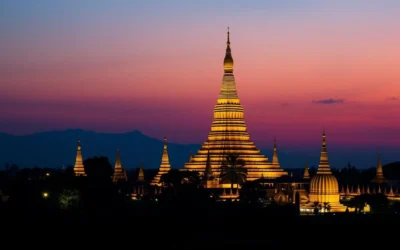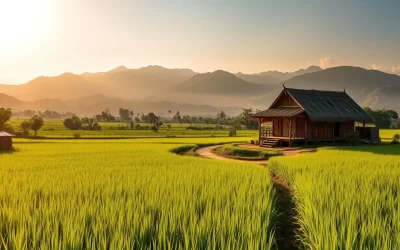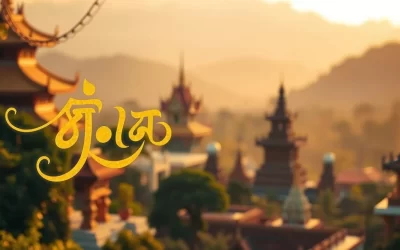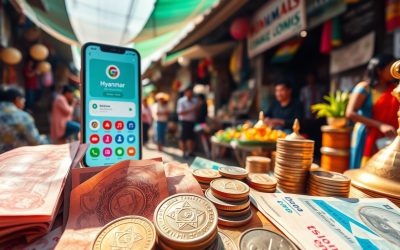Imagine immersing yourself in a vibrant culture where spiritual traditions come alive through colorful festivals. Myanmar, known for its rich cultural heritage, offers a unique travel experience with its diverse festivals throughout the year.
As you plan your trip, consider timing your visit to coincide with one of these extraordinary festivals. From water-splashing celebrations to serene candlelit ceremonies, Myanmar’s festivals showcase the country’s deep-rooted traditions and cultural richness.
By experiencing these festivals, you’ll gain a deeper understanding of the local culture and create unforgettable memories of your journey.
The Rich Festival Culture of Myanmar
The festival culture in Myanmar is a vibrant reflection of its people’s traditions and values. As you explore this beautiful country, you’ll discover that its festivals are not just celebrations but a way of life. These events are deeply intertwined with the country’s predominant religion, Buddhism, and its rich cultural heritage.
The Significance of Festivals in Burmese Culture
Festivals in Myanmar serve as more than just celebrations—they’re living museums of Burmese cultural heritage that have been preserved through generations. The significance of these festivals lies in their ability to bring communities together, promote social cohesion, and provide a platform for the expression of cultural identity. By participating in these festivals, you’ll experience the warmth and hospitality of the Burmese people.
Some key aspects of festivals in Myanmar include their timing, which is heavily influenced by the Buddhist calendar. Many major celebrations coincide with full moon days that hold special significance in Buddhist tradition.
| Festival | Significance | Timing |
|---|---|---|
| Tazaungmone | Lighting of oil lamps and offering gifts to the Buddha | Full moon day of Tazaungmone |
| Thingyan Water Festival | Myanmar’s New Year Celebration | Mid-April |
| Taunggyi Hot-Air Balloon Festival | Celebration of Buddhist traditions with hot-air balloons | November |
How Festivals Connect to Buddhism and Local Traditions
Myanmar’s festivals are intricately connected to Buddhism and local traditions. The country’s predominant religion, Buddhism, plays a central role in shaping the timing and nature of its festivals. Monks are key participants in many of these events, leading chanting, alms-collecting, and blessing ceremonies that form the spiritual backbone of these cultural events.
The fusion of pre-Buddhist animist beliefs with Buddhist practices creates a unique festival culture where ancient pagoda festivals coexist with ceremonies honoring local nature spirits. Understanding this blend of traditions helps you appreciate the deeper meaning behind the colorful celebrations and ritualistic practices you’ll encounter.

Myanmar’s Top Festivals to Check Out When Visiting
As you plan your trip to Myanmar, be sure to coincide your visit with one of its many exciting festivals. The country is known for its rich cultural heritage, and its festivals are a reflection of this. From the water fights of the Thingyan Water Festival to the illuminated lamps of the Tazaungdaing Festival of Lights, there’s always something to celebrate in Myanmar.
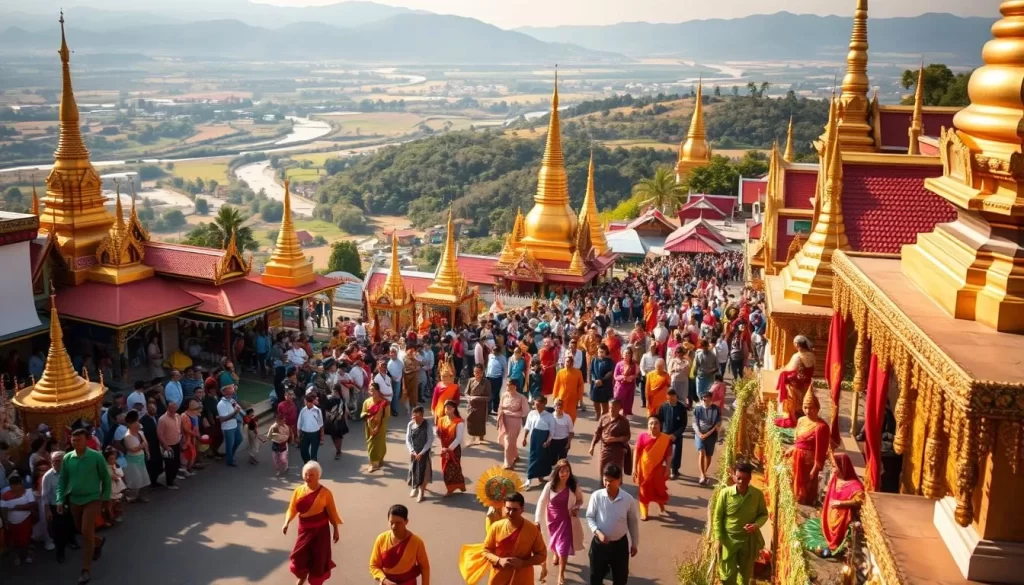
Thingyan Water Festival – Myanmar’s New Year Celebration
The Thingyan Water Festival marks the beginning of Myanmar’s New Year, typically held in mid-April. It’s a time when the country’s cities turn into giant water fight arenas, with locals and tourists alike participating in the cleansing ritual. Water is considered a symbol of washing away past mistakes, making it a fun and refreshing way to start the New Year. Kids love running around, dumping water on their friends, and playing with water pistols, while older people and monks tend to be spared. The biggest celebration is held in Yangon, making it a memorable experience for visitors.
Tazaungdaing Festival of Lights
The Tazaungdaing Festival of Lights takes place during the full moon of November, illuminating the entire country with thousands of oil lamps and lanterns. This magical atmosphere celebrates Buddha’s return from heaven, creating a serene and peaceful ambiance. People gather to admire the lights, making it a wonderful experience for those visiting during this time.
Taunggyi Hot-Air Balloon Festival
At the Taunggyi Hot-Air Balloon Festival, enormous paper balloons decorated with intricate designs are released into the night sky, accompanied by dazzling fireworks. This spectacle creates one of Southeast Asia’s most photogenic celebrations, attracting visitors from around the world. The festival is a testament to the creativity and craftsmanship of the local people.
Ananda Pagoda Festival in Bagan
The ancient city of Bagan hosts the Ananda Pagoda Festival in January, where thousands of villagers arrive by traditional oxcart to camp around the temple. This creates a medieval-like atmosphere among the archaeological wonders, providing a unique and immersive cultural experience. Visitors can enjoy traditional dances, music performances, and local food, making it a memorable trip.
Each of these major festivals offers a unique glimpse into Myanmar’s diverse cultural heritage. While the spiritual aspects remain central, they’ve also evolved into important social gatherings where communities reunite and share in collective joy. The timing of these festivals follows Myanmar’s lunar calendar, so exact dates vary from year to year, making advance planning essential for travelers.
Seasonal Festival Highlights Throughout the Year
From the cool season to the rainy months, Myanmar’s festivals offer a unique glimpse into the country’s traditions and customs. The festival calendar is filled with exciting events that reflect the country’s rich cultural heritage and Buddhist practices.
January-March: Celebrating the Cool Season
During the cool season, Myanmar hosts some of its most significant religious festivals. The Ananda Pagoda Festival in Bagan is a highlight, where thousands gather around the ancient temple for 15 days of celebration. This festival is a perfect example of how Myanmar’s festivals connect to Buddhism and local traditions.
The cool season is an ideal time to experience Myanmar’s culture, with comfortable temperatures and a range of festivals to enjoy. You can witness the traditional oxcarts still used by some villagers to travel to the festival, a testament to the enduring customs of the region.
April-June: Welcoming the Hot Season
As the hot season arrives, Myanmar celebrates with the famous Thingyan Water Festival, marking the country’s New Year. This water-splashing tradition offers welcome relief from the heat and is a fun experience for visitors. The festival is a significant event in Myanmar’s calendar, symbolizing renewal and cleansing.
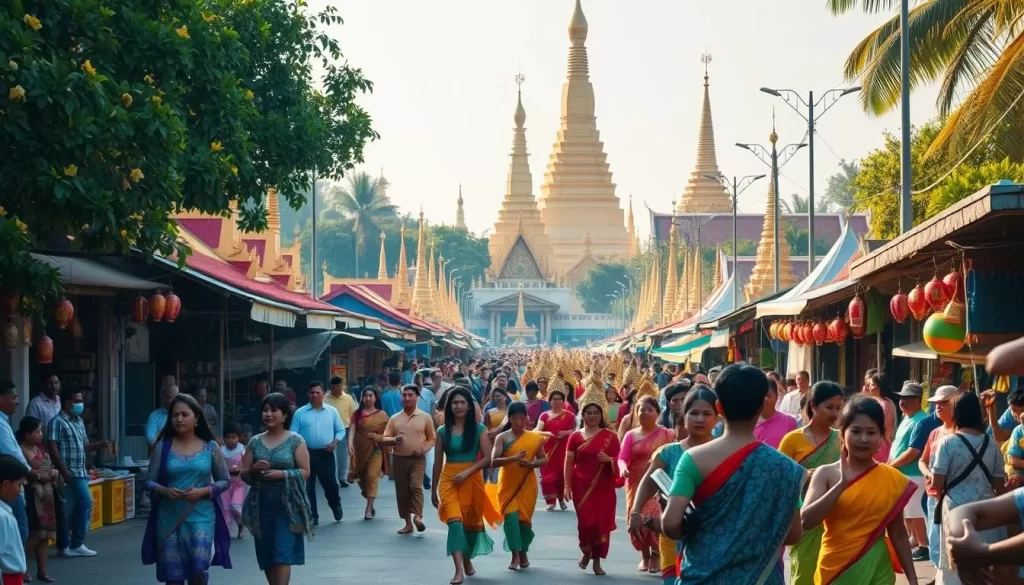
July-October: Festivals During the Rainy Season
The rainy season brings its own unique festivals, showcasing Myanmar’s agricultural heritage. The Festival of Lights in October is a spectacular event, illuminating the country during the full moon. This festival is a beautiful representation of Myanmar’s culture, with celebrations tied to planting and harvesting.
| Season | Festivals | Highlights |
|---|---|---|
| Cool Season (Jan-Mar) | Ananda Pagoda Festival | 15-day celebration at Bagan |
| Hot Season (Apr-Jun) | Thingyan Water Festival | Water-splashing tradition, New Year celebration |
| Rainy Season (Jul-Oct) | Festival of Lights | Illuminations during October’s full moon |
Myanmar’s festival calendar is a reflection of the country’s deep-rooted culture and traditions. By understanding the seasonal timing of these festivals, you can plan your visit to coincide with the celebrations that interest you the most.
Lesser-Known but Fascinating Myanmar Festivals
While many are familiar with Myanmar’s major festivals, there are several lesser-known celebrations that showcase the country’s diverse ethnic traditions. These festivals offer a unique opportunity to experience the authentic culture of Myanmar’s various ethnic groups.
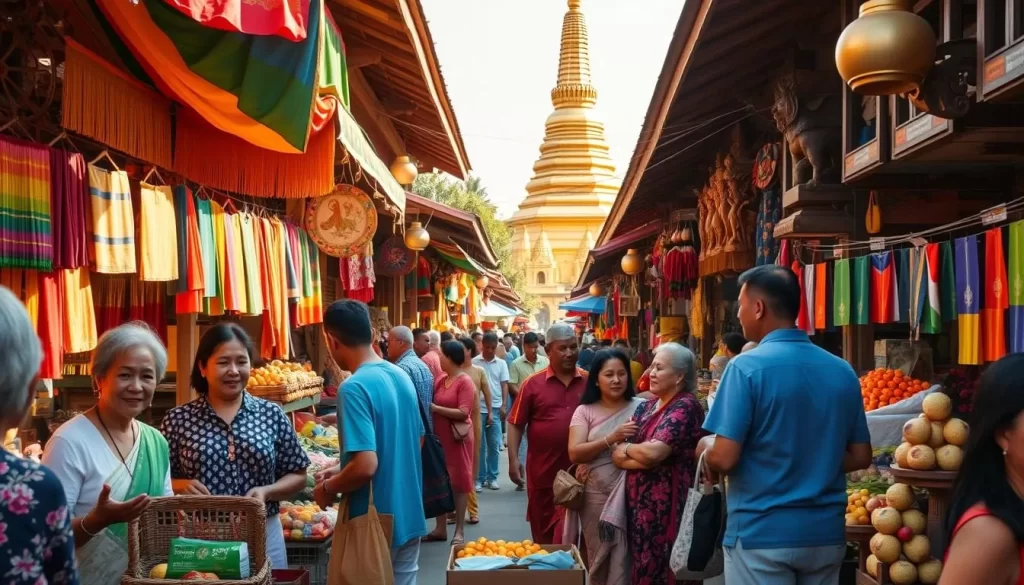
Celebrating Tribal Heritage: Kachin Manaw Festival
The Kachin Manaw Festival, held around the beginning of January in the Kachin state, is a vibrant celebration that brings together various hill tribes to honor their heritage and past victories. This exuberant festival features traditional dances around totem poles, representing tribal unity and heritage. You can experience the rich customs and traditions of the Kachin people through their traditional food, dancing, and performances.
A Glimpse into Indigenous Culture: Naga New Year Festival
The Naga New Year Festival is another fascinating celebration that showcases the distinctive culture of the Naga people along the Indian border. Warriors in traditional dress perform ceremonial dances that are rarely witnessed by international visitors. This festival provides a unique insight into the Naga people’s rich cultural heritage and their New Year traditions.
Myanmar’s Literary Celebration: Sarsodaw Day
Sarsodaw Day, celebrated on the full moon day of Tazaungmone, is a unique festival that honors Myanmar’s literary traditions. The festival features poetry readings and cultural performances that highlight the country’s intellectual heritage. You can experience the rich literary culture of Myanmar through these events, which showcase the country’s rich literary traditions.
These lesser-known festivals in Myanmar offer a fascinating glimpse into the country’s diverse ethnic traditions and regional cultures. By attending these festivals, you can gain a deeper understanding of the country’s complex cultural mosaic and experience the rich cultural heritage of its people.
Practical Tips for Attending Myanmar Festivals
To make the most of your visit to Myanmar’s vibrant festivals, it’s essential to be aware of a few practical tips. Attending a festival in Myanmar can be a once-in-a-lifetime experience, and being prepared will enhance your enjoyment.
What to Wear and Bring
When attending Myanmar’s festivals, especially those at religious sites like pagodas, dress modestly with shoulders and knees covered. Pack essentials like a water bottle, sun protection, and comfortable footwear. For water-related festivals, bring waterproof protection for your belongings.
Cultural Etiquette to Observe
Understanding cultural etiquette will enhance your festival experience. Avoid pointing feet toward Buddha images, ask permission before photographing locals, and follow the lead of Myanmar people regarding appropriate behavior.
Planning Your Trip Around Festival Dates
Planning your trip around Myanmar’s festival calendar requires flexibility, as most celebrations follow the lunar calendar. Consider visiting popular destinations like Inle Lake during shoulder seasons to secure better accommodation rates.
Conclusion: Experiencing the Magic of Myanmar Through Its Festivals
The diverse festivals of Myanmar offer a unique glimpse into the nation’s soul. By participating in these vibrant celebrations, you’ll experience the country’s rich cultural heritage firsthand. From the Taunggyi balloon festival to the Tazaungdaing festival during the full moon, each event provides a memorable experience. Whether you’re visiting famous sites like Shwedagon Pagoda or exploring lesser-known destinations, Myanmar’s festivals will enrich your trip and create lasting memories.
The above is subject to change.
Check back often to TRAVEL.COM for the latest travel tips and deals.
Here are some Tours & Sightseeing suggestions that might pique your interests!

